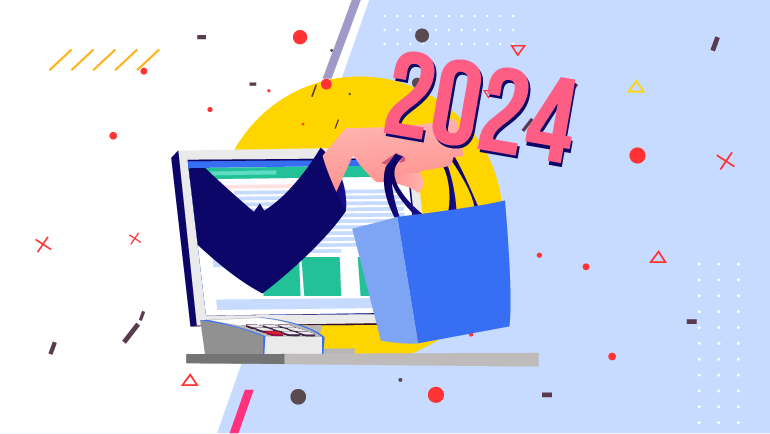Eleven seconds might not seem like much, but it’s the benchmark for online shoppers. Fail to capture their attention or guide them to their desired destination within this window, and you risk losing them altogether. With e-commerce now an irrevocable part of how we shop, the expectations for a streamlined website experience have never been higher. How does a business meet these fleeting timelines? The answer lies in optimal website design.
Survey data reveals intriguing insights into the likes and dislikes of online shoppers, highlighting the need for effective and efficient e-commerce website features. It’s not merely about stunning visuals or catchy slogans; it’s about reducing friction points. The insights that follow are drawn from an online survey involving 2,000 U.S. adults, meticulously planned to reflect the nuances of consumer behavior.
72% report that a poorly designed website affects their opinion of a business
Navigating a poorly designed website isn’t just a test of patience; it’s a deal-breaker. The repercussions are severe, with a notable impact on consumer opinion, business credibility and even referral potential.
A cluttered navigation menu or a cumbersome checkout process isn’t a mere inconvenience; it’s a hit to your brand’s integrity. Imagine walking into a disorganized store with products scattered around—you’d question the professionalism of the operation. The same sentiment extends online.
Missing the mark on your website design has long-lasting consequences:
- It directly chips away at your business’s credibility, leading many to question its professionalism.
- The potential for word-of-mouth referrals takes a hit, cutting off a valuable marketing channel.
- Customer retention falters, with some visitors unwilling to return due to their initial experience.
- How quickly website users expect to find what they are looking for
In the e-commerce arena, 11 seconds might as well be an eternity. Within this brief window, consumer judgments crystallize, influencing brand perception and shaping future interactions. The importance of these initial moments cannot be overstated, providing a wealth of angles to explore.
Search bar placement:
The accessibility and responsiveness of this feature can either fast-track a user toward what they seek or add frustrating seconds to the clock.
Product categories:
Clarity and navigability here can mean the difference between a user becoming a customer or just another bounce rate statistic.
Font and color schemes:
These elements are far from superficial; they can significantly impact how long users stay and what they take away from their visit.
Top website features that impact user experience the most
When it comes to online shopping, the devil is in the details—the design elements. Data points to specific features that serve as catalysts for a satisfying user experience. Interestingly, these are not always grand innovations but often basic elements, fine-tuned for maximum impact.
Quick load time:
When every second counts, a slow-loading page can be the equivalent of a closed door to potential customers.
Streamlined checkout process:
A convoluted checkout can cause cart abandonment rates to spike, undermining the initial engagement.
Relevant product recommendations:
Algorithms that surface apt products add a layer of personalization that can convert one-time shoppers into repeat customers.
Video content is the most important website feature for users
While the buzz around video content often suggests it’s the uncontested champion of website features, our data tells a more nuanced story. Video content, at 83%, holds a thin lead over other highly rated functionalities. Consider these insights:
Video content (83%):
No longer an optional embellishment, video content has elevated itself to be a fundamental part of a website’s architecture. It has an unmatched capacity to both convey complex messages and forge emotional connections.
Mobile-friendly (82%):
Hot on video’s heels, mobile compatibility shows that users expect seamless transitions between different screens, making adaptability more than just a catchphrase—it’s a user demand.
Individualized content (75%):
As algorithms grow more sophisticated, users increasingly expect personalization. Tailored content isn’t a luxury; it’s now as expected as high-quality graphics or responsive design.
Interactive designs, location-specific information and social media accessibility (74%):
These features collectively indicate that users are looking for dynamic and contextually relevant experiences, whether that’s through engaging designs, geo-targeted information or easy transitions from their social feeds.
Personalized recommendations (73%):
Slightly trailing other features, the desire for automated yet pertinent suggestions indicates that savvy algorithms are more than a backend gimmick—they’re front and center in user engagement strategies.
Website features that users find most annoying
If there’s a flip side to user delight, it’s user frustration, and the line between the two is razor-thin. Our data reveals specific elements that can erode the user experience, offering valuable insights into the pitfalls to avoid. Here’s what annoys users the most:
Auto-playing video content (52%):
It seems the same feature that can captivate can also aggravate. Video content, if not deployed judiciously, can backfire by disrupting a user’s flow and consuming valuable bandwidth.
Pop-up ads (48%):
The bane of nearly half our respondents, pop-up ads suggest that intrusive marketing tactics are not only outdated but may also be counterproductive.
Live chat pop-ups (45%):
These can often feel like a virtual salesperson lurking over your shoulder, adding pressure rather than assistance to the browsing experience.
Unattractive layout or content (35%):
Aesthetic matters. An unappealing layout can affect a user’s level of engagement and may also tarnish perceptions of a brand’s quality.
Subscription or sign-up messages (34%):
Users have signaled that constant nudges to commit can be a turnoff, particularly when they obstruct the user’s immediate goals.
Slow loading speeds (26%):
Not a trifling issue by any stretch, slow loading times can push users to abandon a website and not return, thereby impacting traffic and potential revenue.
Outdated design and poor search functionality (9%):
While fewer respondents found these aspects bothersome, they can’t be dismissed outright. A dated look can suggest stagnation, and inadequate search features can be a barrier to quick and effective site use.



